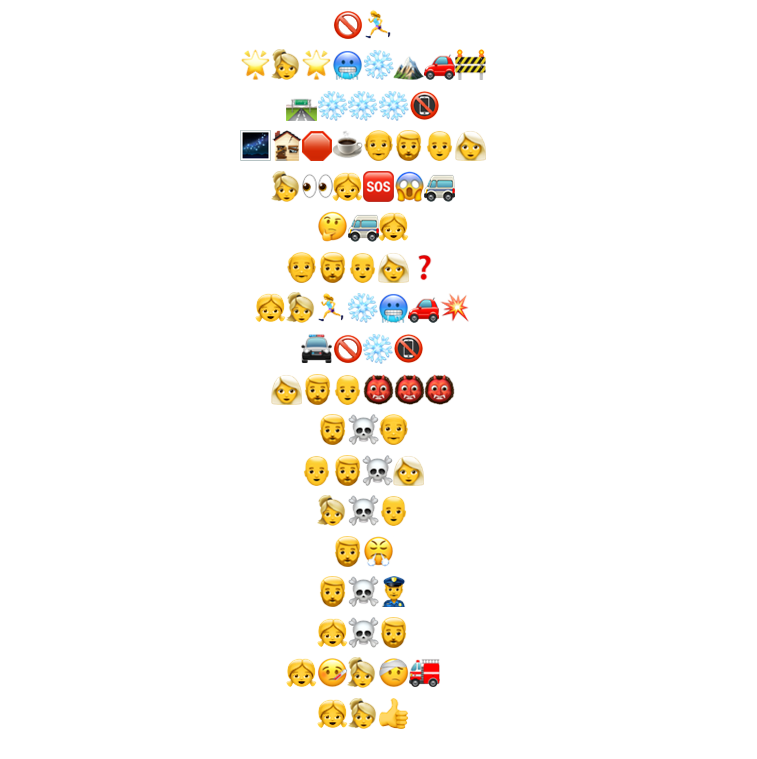
I recently finished a novel, which was an enjoyable read as it is a thriller so it is outside of the genres that I am typically drawn to. However, I am glad that I read it though, as the description of the plot makes for an exciting “Emoji Story”. I began with the title and tried to convey some of the main events that happened in the story, but describing actual scenes was too complicated. One of the main difficulties that I had when writing this story had to do with not being able to find an emoji that accurately depicted the word that I wanted to write, especially the verbs. I was also aware that many of the emojis have double meanings, which makes it even more difficult. For example, when I used the ☠️ emoji, I was using it to mean “killed”, but it could also be danger or poison, yet I also know that youth today are using it to mean extremely funny. I actually asked my teenage son about this, and he told me that he only uses it sparingly to refer to something that is really, really funny. In his words, “it’s so funny that you died laughing”. It is interesting how the “etymology of emojis” which are still relatively new is already evolving and that so many are becoming homonyms, not unlike so many of the words in the English language.
Therefore, it was interesting then to reflect upon what Kress (2005) says about the limitation of words, and how “if there is no word, then the possibility of representation and communication is ruled out. Only that which is worded can enter into communication; or else, that which is to be represented gets squeezed into the ill-fitting semantic shape of the existing world” (p. 15). I would suspect this is one of the reasons that we have so many homonyms in English, which can be incredibly confusing to individuals who are just learning to speak a language, or those who are not as familiar with popular culture. Thus, it really is through the combination of text and images that we are able to communicate in richer detail, which then helps to explain the widespread appeal of the internet, and incorporating emojis into casual text has become so popular. It is why even though I have always loved to read books, I have found myself over the past 20 years, spending way more time reading the internet than books. Sadly, it is actually unusual for me to have recently read a novel, as most of the reading that I do currently is either academic, or on the internet. I have often felt guilty about infrequently I read books compared to in my childhood and youth. However, as Bolter (2001) describes that with the internet’s combination of text and visuals “it becomes hard to imagine how traditional prose could successfully compete with the dynamic and heterogeneous visual experience that the Web now offers” (p. 70). Text plus visuals helps us to communicate more effectively and it is more engaging. If we include the emoji in this, then we can see it as being more than just a casual piece of pop culture.
I think that the fact that text in combination with visuals is something that is really important for teachers to reflect upon, especially in the context of teaching children how to write. It is easy to get stuck in a mindset of viewing learning to write as something that young children NEED to ALWAYS do with paper and pen/pencil. Inevitably, many students struggle with writing and show little engagement in the process. I recently saw a post in a group that I am in where someone was asking what to do with their students in a primary grade that were struggling with writing, as they were distracting the class during their writing block each day and refused to write. The teacher felt that she was providing appropriate scaffolding with sentence starters, or offering to scribe, but none of this was working. I could not help but feel that while these students probably needed more scaffolding or the task was too hard, they probably also needed to be engaged in writing again and see it as a valuable means of communication. This “Emoji Story” task that I am being asked to do actually sprang to mind, as something that would be fun to do with K-12 students. Fully incorporating the text and literacies that the students see everyday in the world around them is engaging, but also critical in developing the literacy skills they need for the 21st century.
P.S. In retrospect, I wish that I had chosen a book or show that was more familiar to everyone to make it easier to guess! However, here is a link to the book for anyone that is curious: click to follow the link for the answer.
References
Bolter, J. D. (2001). Writing space: Computers, hypertext, and the remediation of print (2nd ed.). Mahwah, N.J: Lawrence Erlbaum Associates.
Kress, G. (2005). Gains and losses: New forms of texts, knowledge, and learning. Computers and Composition, Vol. 2(1), 5-22.

One response to “An Emoji Story Task”